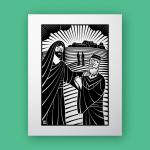We wake, if we ever wake at all, to mystery, rumors of death, beauty, violence. . . . “Seem like we’re just set down here,” a woman said to me recently, “and don’t nobody know why.” Annie Dillard, Pilgrim at Tinker Creek
A few weeks ago I posted the following on Facebook: What books have changed your life? I don’t mean which books do you think are “greatest” or at the top of the “Great Books” canon, but which books came along at just the right time in your life and changed something significant? The response was fascinating, with dozens of my Facebook acquaintances (and theirs) listing interesting and eclectic offerings from Dr. Seuss to Dostoevsky. I listed four books that fit my “this book changed my life” category, books that I’ll be writing about over the next few weeks. Up first is Annie Dillard’s Pilgrim at Tinker Creek.

At a writer’s workshop several summers ago one of the writing coaches gave us writer wannabes a terrific question to ask every time we write. “With Middlemarch and Pilgrim at Tinker Creek in the world, why would anyone be interested in this?” Over the twenty-five years or so since I read Pilgrim at Tinker Creek for the first time, I have occasionally mentioned to friends whose opinions I highly respect how the book has influenced me.
More often than not, my friend has replied that she read it years ago and didn’t finish it, or he confesses that “I just don’t get it.” One said “I didn’t like it much when I read it, but I’ve never been able to forget it.” I understand these reactions—Dillard’s 1974 Pulitzer Prize winner is odd, quirky, eclectic, and one-of-a-kind. And it has helped me to see the world around me and myself differently.
Our life is a faint tracing on the surface of mystery, like the idle, curved tunnels of leaf miners on the face of a leaf. We must somehow take a wider view, look at the whole landscape, really see it, and describe what’s going on here.
Annie Dillard is an intense observer of details, capable of seeing things that escape the notice of just about everyone. She finds worlds of complexity and interest in the tiniest matters—I often think of Dr. Seuss’s Horton Hears a Who when I read Dillard. But I have encountered skilled natural observers before—what makes Dillard different is that she invites the reader into a new kind of seeing altogether. Given, as she writes, that most of us “waste most of our energy just by spending every waking minute saying hello to ourselves,” how do we learn to get out of the way and see what is actually there instead of what we expect to see?
There is another kind of seeing, which involves a letting go. When I see this way I sway transfixed and emptied. The difference between the two ways of seeing is the difference between walking with and without a camera. When I walk with a camera I walk from shot to shot, reading the light on a calibrated meter. When I walk without a camera, my own shutter opens, and the moment’s light prints on my own silver gut. When I see this second way I am above all an unscrupulous observer.
And what Dillard sees is that “Terror and a beauty insoluble are a ribbon of blue woven into the fringes of garments of things both great and small.” From the slow-train-wreck horror of watching a giant water bug paralyze a small frog then suck the frog’s insides out through a puncture hole to the gratuitous beauty of a mockingbird free-falling from a five-story roof only to swerve and land light as a feather just a couple of feet before crashing into the earth—just because it can—Dillard finds that we are surrounded by endless details that belie our constant attempts to categorize and “figure out.”
Dillard is not the least bit hesitant to ask the big questions that arise from her intense attention to detail. As she describes it in another of her books, she continually participates in “unlicensed metaphysics in a teacup.” Our attempts to understand the big picture, however, must always begin with what is the case rather than what we would like to be the case. This requires learning how to see unfiltered.
What we know, at least for starters, is here we—so incontrovertibly—are. This is our life, these are our lighted seasons, and then we die. In the meantime, in between time, we can see. The scales are fallen from our eyes, the cataracts are cut away, and we can work at making sense of the color patches we see in an effort to discover where we so incontrovertibly are. It’s common sense: when you move in, you try to learn the neighborhood.
Practicing this sort of seeing was an “eye opener” for me (pun intended), opening previously undiscovered pathways I had always longed to follow. They led to ways of thinking about God that blew me away.
We have not yet encountered any god who is as merciful as a man who flicks a beetle over on its feet. There is not a people in the world who behaves as badly as praying mantises. But wait, you say, there is no right and wrong in nature; right and wrong is a human concept. Precisely: we are moral creatures, then, in an amoral world. The universe that suckled us is a monster that does not care if we live or die—does not care if it itself grinds to a halt.
Pilgrim at Tinker Creek is packed with page after page of excruciatingly detailed observations of violence and ugliness in the natural world, to the extent that my students sometimes wonder why Dillard finds it necessary to pound her readers over their heads with a basic fact: Nature is both violent and beautiful, deadly and life-giving. “Enough already!” they complain. Dillard’s point is not to fill up pages but rather to force us to face the implications of what we are seeing, including what these truths tell us about what is greater than us. What sort of being or process is responsible for this?
How many people have prayed for their daily bread and famished? They die their daily death as utterly as did the frog, people, played with, dabbled upon, when God knows they loved their life. In a winter famine, desperate Algonquin Indians “ate broth made of smoke, snow, and buckskin, and the rash of pellagra appeared like tattooed flowers on their emaciated bodies—the rose of starvation, in a French physician’s description; and those who starved died covered with roses.” Is this beauty, these gratuitous roses, or a mere display of force? Or is beauty itself an intricately fashioned lure, the cruelest hoax of all?
Dillard knows full well that such Job-like challenges to the Divine are “out of bounds” in many circles, but she isn’t having it. “We are people,” she writes, “we are permitted to have dealings with the creator and we must speak up for the creation. God look at what you’ve done to this creature, look at the sorrow, the cruelty, the long damned waste!” As she asks elsewhere, “What the Sam Hill is going on here?” The fact is that what we are seeing is not what we would expect to see in a natural world created and overseen by a benevolent deity. Setting aside traditional constructs and concepts, Dillard freely explores other possibilities.
Could it be that if I climbed the dome of heaven and scrabbled and clutched at the beautiful cloth till I loaded my fists with a wrinkle to pull, the mask would rip away to reveal a toothless old ugly, eyes glazed with delight?
I had wondered about this since my early years as a young Baptist boy, but this was the first time I found it in print. And it inspired me to fearlessly track what I see to what might be behind the scene—regardless of where it might take me.
But as Dillard regularly reminds her readers, terror and beauty are intertwined in our world, so intimately that our attempts to separate them will invariably fall short.
No, I’ve gone through this a million times, beauty is not a hoax—how many days have I learned not to stare at the back of my hand when I could look out at the creek? . . . Beauty is real. I would never deny it; the appalling thing is that I forget it.
When I remember to get out of my own way, Pilgrim at Tinker Creek serves as a standard for me, a standard of how to see differently. This theme of learning how to truly see weaves through many of the texts that have influenced me over the past several years—Annie Dillard was the first to introduce me to it.
The secret of seeing is, then, the pearl of great price. . . . But although the pearl may be found, it may not be sought. The literature of illumination reveals this above all: although it comes to those who wait for it, it is always, even to the most practiced and adept, a gift and a total surprise.













